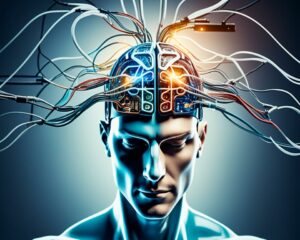Adverts
In today's highly connected digital environment, cybersecurity has become a critical priority. A artificial intelligence (AI) is being used to improve cybersecurity in several areas. AI offers threat detection advanced, attack prevention, rapid incident response and biometric authentication. It is also helping to face the evolution of cyber threats, becoming a necessity in the current scenario. However, in addition to the benefits, the adoption of AI in cybersecurity it also brings challenges and ethical concerns that need to be addressed.
Main points to note:
- Protect yourself against digital threats with the use of artificial intelligence in cybersecurity.
- AI offers advanced defenses It is advanced technology to guarantee the online protection.
- A evolution of cyber threats makes the adoption of AI even more essential in cybersecurity.
- While it brings benefits, AI also presents challenges and ethical concerns that need to be addressed.
The Evolution of Cyber Threats and the Importance of AI.
Cyber threats have evolved significantly over time, from the first computer viruses to more sophisticated attacks such as malware advanced and advanced persistent threats (APTs). AI has been an effective response to these ever-evolving threats.
Adverts
Using algorithms and behavioral analysis, the artificial intelligence (AI) delivers advanced threat detection, rapid incident responses, and proactive prevention. By analyzing patterns of suspicious activity, AI can identify possible cyber attacks and take measures to mitigate these threats.
Furthermore, AI plays a key role in biometric authentication, making it more secure and convenient. Through facial recognition, fingerprints and other biometric technologies, AI helps protect valuable data and resources from unauthorized access.
Adverts
A evolution of cyber threats requires advanced and adaptable solutions. AI provides this capability by enabling the detection and blocking of cyber attacks In real time. It uses machine learning techniques to analyze large volumes of data and identify unusual patterns that could indicate malicious activity.
In summary, the adoption of AI in cybersecurity is essential to face the challenges of cyber attacks increasingly sophisticated. It not only offers advanced protection against malware, hackers and APTs, but also strengthens biometric authentication, ensuring a safer digital environment for individuals and organizations.
Table example:
| Threat Type | Description |
|---|---|
| Malware | Malicious software designed to damage, gain unauthorized access to, or control a computer system or network. |
| Hackers | Individuals with technical skills who exploit vulnerabilities in computer systems with the aim of gaining unauthorized access or causing harm. |
| APTs | Advanced persistent threats are highly sophisticated and targeted cyberattacks, often sponsored by governments or organized criminal groups. |
How AI Works in Cybersecurity.
A AI in cybersecurity works as a machine learning system that uses algorithms and data analysis. It is trained with network traffic information, system activity patterns, and cyber threat data. AI has the ability to identify abnormal activity in real time, such as hacking attempts, malware, and phishing threats.
An example of how AI works is through predictive models. Through training with large volumes of data, AI is able to identify patterns, anomalies and suspicious behaviors in network traffic. Based on these analyses, AI can determine whether a given activity is malicious or legitimate.
See too:
“AI in cybersecurity is capable of identifying abnormal activity in real time, such as hacking attempts, malware, and phishing threats.”
Additionally, AI helps reduce human errors in cybersecurity. While humans can get tired, distracted or make mistakes, AI is capable of analyzing data consistently and accurately. This way, it can detect and respond to threats in real time, without delays or human error.
A intelligent automation it is also an important feature of AI in cybersecurity. AI is capable of automating threat detection, attack prevention and incident response. This allows security teams to act quickly and efficiently to neutralize threats, minimizing the impact on systems and data.
Rapid incident response is another key benefit of AI in cybersecurity. AI can provide immediate insights into a detected threat, enabling security teams to take immediate corrective action. This helps prevent the spread of threats and minimize the damage caused.
In short, AI in cybersecurity works as a machine learning system trained to identify cyber threats and take appropriate actions. It offers advanced threat detection, intelligent automation, attack prevention It is rapid response to incidents. By harnessing the power of AI, organizations can strengthen their cybersecurity and protect their digital assets.
Benefits of AI in Cybersecurity:
- Advanced real-time threat detection
- Reduction of human errors
- Intelligent automation of security processes
- Rapid incident response
AI in cybersecurity offers a proactive and effective approach to addressing digital threats constantly evolving. It enables organizations to protect their systems and data more efficiently, ensuring a secure online environment.
Challenges and Ethical Considerations of AI in Cybersecurity.
The adoption of AI in cybersecurity brings with it a series of challenges that need to be faced responsibly and ethically. One of the main challenges is the fact that adversaries can also use AI to enhance their attacks. This means that cybercriminals can exploit this advanced technology to create even more sophisticated threats, making cybersecurity a constant race between attack and defense.
Furthermore, issues related to privacy and to responsible use of AI must also be considered. The collection and processing of large volumes of data can raise concerns about the protection of privacy of users and the security of this information. It is essential to ensure the security of data entered into AI queries, as well as the data integrity of the language models used.
Another ethical challenge is avoiding problems such as copyright infringement, exposure of personal information and use of biased data. AI, if not used responsibly, can perpetuate existing biases and discrimination in the data used to train models, resulting in unfair or harmful decisions.
The responsible use of AI in cybersecurity is essential to maximize its benefits and minimize risks. This involves implementing data protection measures and privacy, as well as the adoption of good practices in the training and use of AI models, taking into account ethical and legal aspects.
Ethical Considerations in Cybersecurity with AI
| AI Challenges in Cybersecurity | Ethical Considerations |
|---|---|
| Opponents using AI to create more sophisticated attacks | Protection of user data and privacy |
| Data integrity of language models | Responsible use of AI |
| Copyright infringement | Avoid bias and discrimination in data |
The goal is to ensure that AI is used ethically and responsibly, with a focus on data protection, privacy and the benefit of society as a whole. Advanced cybersecurity depends not only on technology, but also on ethical considerations and responsible actions.
The Role of AI in Strengthening Cybersecurity.
AI plays a key role in transforming cybersecurity. It helps strengthen security by detecting anomalous activity in real time, providing rapid responses to attacks, and operating fundamental models in private environments to ensure data confidentiality.
The use of AI in cybersecurity allows the detection of suspicious activities and the identification of possible threats in real time. Through data analysis, AI is capable of identifying attack patterns and predicting anomalous behavior, strengthening organizations' ability to protect against cyberattacks.
A rapid response to attacks it is an essential aspect of cybersecurity. With AI, it is possible to automate incident response, speeding up reaction time and minimizing potential damage. Furthermore, AI also operationalizes fundamental models in private environments, ensuring greater control and confidentiality of data.
Cybersecurity is a constantly evolving challenge, and AI plays a key role in this context. It adapts to new threats and evolutions in the attack surface, helping to protect digital assets and mitigate risks. Through the operation of fundamental models, AI ensures the effectiveness of defenses against increasingly sophisticated cyber threats.
In summary, AI plays a vital role in cybersecurity, strengthening protection against threats, detecting anomalous activities, ensuring rapid responses to attacks, and operating fundamental models to maintain data confidentiality. Your contribution is essential to face current challenges and ensure a safe digital environment.

Benefits of AI in Strengthening Cybersecurity
- Advanced detection of anomalous activities and cyber threats.
- Rapid response to incidents, reducing damage and costs.
- Operation of fundamental models in private environments to ensure data confidentiality.
- Data analysis to identify attack patterns and prevent future attacks.
Quote:
“AI is a powerful ally in cybersecurity, strengthening organizations’ defenses and enabling a more efficient response to attacks.” – Cybersecurity specialist
Best Practices in Using AI in Cybersecurity.
To ensure cybersecurity and maximize the benefits of artificial intelligence (IA), it is essential to adopt best practices. By implementing these practices, you can mitigate risks and protect your data effectively.
1. Protect Data Privacy
Ensure data confidentiality by operating fundamental models in private environments. This will help prevent unauthorized access and ensure the security of your sensitive data.
2. Use Recovery Augmented Generation
Leverage retrieval-augmented generation to improve the accuracy of AI models without compromising security. This approach allows you to improve the results of your security system without exposing confidential information.
3. Implement Strict Access Controls
To ensure data security, it is essential to implement strict access controls. Utilize technologies like multi-factor authentication and encryption to strengthen your defenses against cyber threats.
4. Train Your Teams
Proper team training is essential to maximizing the potential of AI in cybersecurity. Make sure your team is up to date with best practices and compliance regulations to ensure effective AI implementation.
5. Maintain Regulatory Compliance
It is crucial to comply with cybersecurity regulations and data privacy. This includes being aware of relevant laws, such as the General Data Protection Law (LGPD), and ensuring that your practices comply with these regulations.
“Adopt the best practices in AI It is essential to ensure cybersecurity and protect your digital assets.”
By following these best practices, you will be strengthening your defenses against cyber threats, protecting your data privacy and ensuring compliance with applicable regulations.
| Best practices in AI in Cybersecurity | Benefits |
|---|---|
| Protection of data privacy | Confidentiality and information security |
| Generation increased by recovery | Improved accuracy of AI models |
| Strict access controls | Preventing unauthorized access |
| Team training | Better use and implementation of AI |
| Compliance with regulations | Avoiding penalties and legal problems |
Conclusion.
Cybersecurity is a critical priority in the digital age, and AI plays a key role in this scenario. It offers advanced threat detection, prevention, and response capabilities and strengthens biometric authentication. AI also faces the challenges of ever-evolving cyber threats. However, the adoption of AI in cybersecurity also brings challenges and ethical concerns that need to be addressed.
By adopting best practices and ensuring the responsible use of AI, organizations can harness the potential of this technology to improve their cybersecurity and protect their digital assets.
FAQ
What is AI cybersecurity?
What is the role of artificial intelligence in cybersecurity?
What are the challenges and ethical considerations of adopting AI in cybersecurity?
How does AI work in cybersecurity?
What role does AI play in strengthening cybersecurity?
What are best practices in using AI in cybersecurity?
Source Links
- https://www.dio.me/articles/inteligencia-artificial-ia-no-reforco-da-seguranca-cibernetica-defesas-avancadas-num-mundo-digital-conectado
- https://www.xlabs.com.br/blog/a-inteligencia-artificial-na-seguranca-cibernetica-desafios-e-solucoes/
- https://www.internationalit.com/post/além-do-código-ia-ea-defesa-cibernética-avançada



